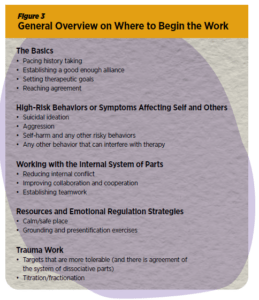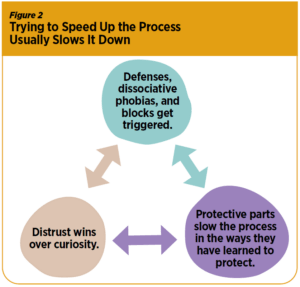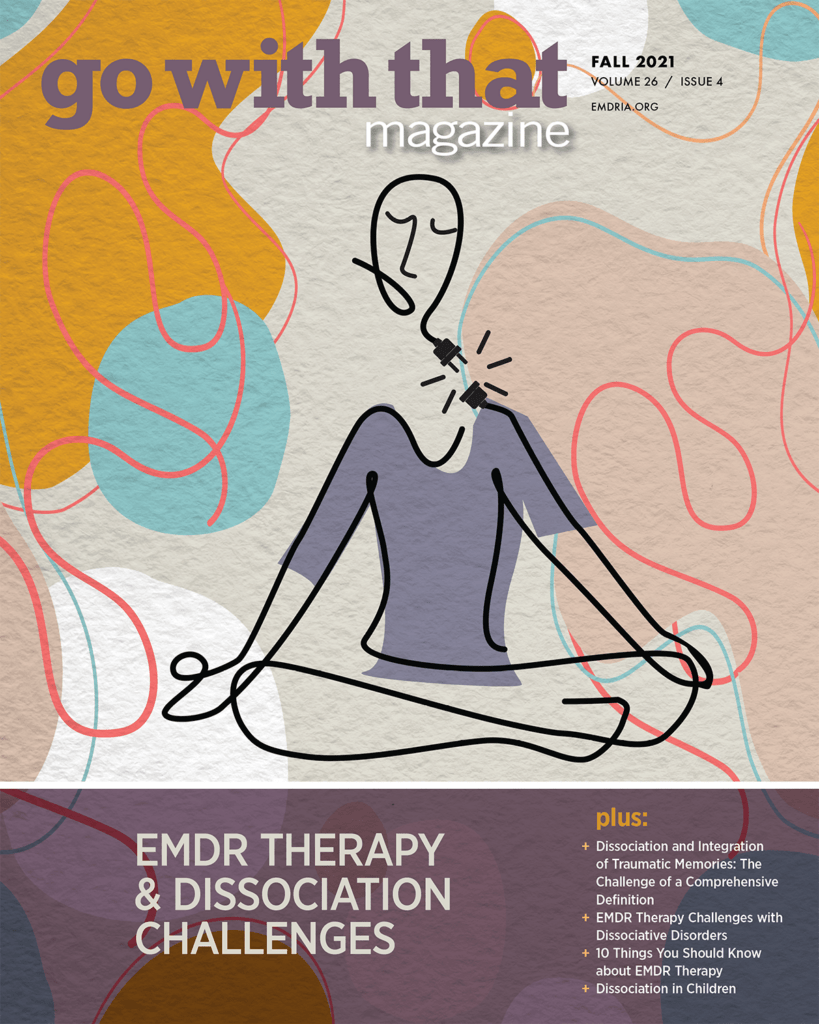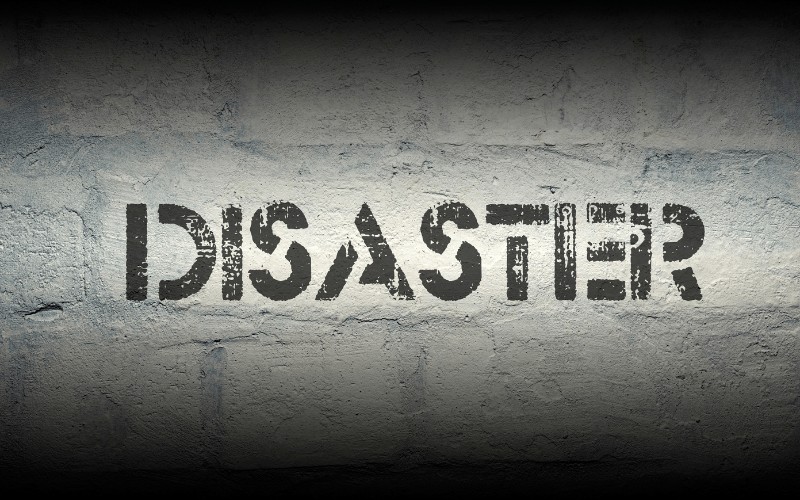Dissociation is a disconnection between a person’s thoughts, sensory experience, memory, and/or sense of identity. On a mild level, dissociation is a common experience that many people recognize as wanting to detach from something that is emotionally stressful. On a more extreme level, it can cause difficulty functioning in everyday life and could create a loss of connection to a person’s sense of self. Dissociation can occur as a result of experiencing trauma. Because EMDR therapy is recognized as a trauma treatment, it is likely that EMDR therapists will treat clients who are experiencing dissociation.
EMDRIA featured the topic of dissociation in the Fall 2021 issue of Go With That Magazine™️. In this issue, expert Dolores Mosquera authored the article “Challenges in the Use of EMDR Therapy with Dissociative Disorders” in which she presents best practices and helpful reminders about using EMDR therapy with clients experiencing dissociation. Mosquera advocates for taking the time needed in Phases 1 and 2 of EMDR therapy to develop trust in the therapeutic relationship, collaborate in case conceptualization and build emotional regulation skills before proceeding on with EMDR reprocessing phases.
with Dissociative Disorders” in which she presents best practices and helpful reminders about using EMDR therapy with clients experiencing dissociation. Mosquera advocates for taking the time needed in Phases 1 and 2 of EMDR therapy to develop trust in the therapeutic relationship, collaborate in case conceptualization and build emotional regulation skills before proceeding on with EMDR reprocessing phases.
Mosquera writes: “Clinicians using Eye Movement Desensitization and Reprocessing (EMDR) therapy often run into difficulties when clients present symptoms indicative of dissociation of the personality involving different dissociative parts. Not only do inexperienced clinicians have doubts about how to work with complex trauma cases, so do experienced clinicians. Therapists often seek consultation due to feeling unsure about the work that can be done, especially with dissociative disorder cases.
 EMDR therapists know that during the reprocessing phases of EMDR, the patient’s adaptive information processing (AIP) system tends to flow spontaneously toward resolution and integration (Shapiro, 1995). In simple trauma cases that do not involve a dissociative disorder, the therapist’s intervention is often minimal, and most blocking points will easily be resolved with brief interweaves. However, using the standard EMDR protocol in complex trauma cases involving dissociative disorders will be more challenging and require a longer preparation phase, a well-defined structure, and fractioned work. Gradually introducing trauma processing or desensitization by titrating and fractioning the work will help these clients remain within their window of tolerance, which will increase their capacity for effective processing.
EMDR therapists know that during the reprocessing phases of EMDR, the patient’s adaptive information processing (AIP) system tends to flow spontaneously toward resolution and integration (Shapiro, 1995). In simple trauma cases that do not involve a dissociative disorder, the therapist’s intervention is often minimal, and most blocking points will easily be resolved with brief interweaves. However, using the standard EMDR protocol in complex trauma cases involving dissociative disorders will be more challenging and require a longer preparation phase, a well-defined structure, and fractioned work. Gradually introducing trauma processing or desensitization by titrating and fractioning the work will help these clients remain within their window of tolerance, which will increase their capacity for effective processing.
This article aims not to go over every approach that has been developed for trauma work but to offer a broad view of some of the aspects that every EMDR therapist should be familiar with when working with dissociative disorder cases.”
Click Here for Full Article in English
Click Here for Full Article in Spanish
Resources on Dissociation and EMDR therapy
Allen, T. (2019, Oct 8). Too cautious or not cautious enough: Thoughts on the need for dissociation training for EMDR therapists. The Institute for Creative Mindfulness. https://www.instituteforcreativemindfulness.com/icm-blog-redefine-therapy/too-cautious-or-not-cautious-enough-thoughts-on-the-need-for-dissociation-training-for-emdr-therapists-by-teresa-allen-mft?fbclid=IwAR1c8Gy0KZRJSIIV6KiAFmsT2jE8TRj3KOD_OO9kFY1t8FDLB1NMHpJdzt8
Boon, S., Steele, K., & van der Hart, O. (2011). Coping with trauma-related dissociation: Skills training for patients and their therapists. New York, NY: W. W. Norton & Company.
Cotterman, A. (2020, October 6). 5 things I wish my loved ones knew about dissociation. National Alliance on Mental Illness. https://www.nami.org/Blogs/NAMI-Blog/October-2020/5-Things-I-Wish-My-Loved-Ones-Knew-About-Dissociation
Dell, P. F. (n.d.) The multidimensional inventory of dissociation. https://www.mid-assessment.com/.
Fine, C. G. (1999). The tactical-integration model for the treatment of dissociative identity disorder and allied dissociative disorders. American Journal of Psychotherapy, 53(3), 361-376. Open access: https://doi.org/10.1176/appi.psychotherapy.1999.53.3.361
Fisher, J. (2017). Healing the fragmented selves of trauma survivors: Overcoming internal self-alienation. New York, NY: Routledge
Forgash, C., & Copeley, M. (2008). Healing the heart of trauma and dissociation with EMDR and ego state therapy. New York, NY: Springer Publishing Company.
Forgash, C., & Knipe, J. (2012). Integrating EMDR and ego state treatment for clients with trauma disorders. Journal of EMDR Practice and Research, 6(3), 120-128. Open access: https://doi.org/10.1891/1933-3196.6.3.120
Fraser, G. A. (1991). The dissociative table technique: A strategy for working with ego states in dissociative disorders and ego-state therapy. Dissociation: Progress in the Dissociative Disorders, 4(4), 205-213. Open access: http://hdl.handle.net/1794/1467
Gelinas, D. J. (2003). Integrating EMDR into phase-oriented treatment for trauma. Journal of Trauma & Dissociation, 4(3), 91-135. https://doi.org/10.1300/J229v04n03_06
Gomez, A. M. (2013). EMDR and adjunct approaches with children: Complex trauma, attachment and dissociation. New York, NY: Springer Publishing Company.
Gomez, A., & Paulsen, S. (2016). All the colors of me: My first book about dissociation. Phoenix, AZ: Agate Books.
Gonzalez, A. (2018). Eye movement desensitization and reprocessing (EMDR) in complex trauma and dissociation: Reflections on safety, efficacy and the need for adapting procedures. Frontiers in the Psychotherapy of Trauma and Dissociation, 2(2), 192–211. Open access retrieval from: https://isstdworld.isst-d.org/home/frontiers-open-access
Gonzalez, A. (2018). It’s not me: Understanding complex trauma, attachment and dissociation. Self-published.
Gonzalez, A. & Mosquera, D. (2012). EMDR and dissociation: the progressive approach. [English edition]. Charleston, SC: Amazon Imprint.
Gonzalez-Vazquez, A. I., Rodriguez-Lago, L., Seoane-Pillado, M. T., Fernandez, I., Garcia-Guerrero, F., & Santed-German, M. A. (2018). The progressive approach to EMDR group therapy for complex trauma and dissociation: A case-control study. Frontiers in Psychology, 02377. Open access: https://doi.org/10.3389/fpsyg.2017.02377
International Society for the Study of Trauma and Dissociation. (n.d.). Dissociation FAQs. https://www.isst-d.org/resources/dissociation-faqs/
International Society for the Study of Trauma and Dissociation (ISSTD). (2011). Guidelines for treating dissociative identity disorder in adults. Retrieved from: https://www.isst-d.org/resources/adult-treatment-guidelines/
International Society for the Study of Trauma and Dissociation (ISSTD) Task Force on Children and Adolescents. (2003). Guidelines for the evaluation and treatment of dissociative symptoms in children and adolescents. Retrieved from: https://www.isst-d.org/resources/child-adolescent-treatment-guidelines/
Knipe, J. (2018). EMDR toolbox: Theory and treatment of complex PTSD and dissociation, (2nd ed.). New York, NY: Springer Publishing Company.
Lanius, U.F., Paulsen, S., & Corrigan, F.M. (2014). Neurobiology and Treatment of Traumatic Dissociation: Towards an Embodied Self. New York: Springer Publishing Company.
Liotti, G. (2006). A model of dissociation based on attachment theory and research. Journal of Trauma & Dissociation, 7(4), 55-73. https://doi.org/10.1300/J229v07n04_04
Liotti, G. (2009). Attachment and dissociation. In P. F. Dell & J. A. O’Neil (Eds.), Dissociation and the dissociative disorders: DSM-V and beyond (pp. 53-65). Routledge.
Marich, J. (2018, December 4). A personal (and professional) take on dissociative disorders. The Mighty. https://themighty.com/2018/12/dissociative-disorders-professional-personal-perspective/
Marich, J. (2019, June). Dissociation: Sharing from a personal place. Go With That, 24(2), 5-6. https://www.emdria.org/publications-resources/go-with-that-magazine/
Martin, K. M., (2012). How to use Fraser’s dissociative table technique to access and work with emotional parts of the personality. Journal of EMDR Practice and Research, 6(4), 179-186. Open access: https://doi.org/10.1891/1933-3196.6.4.179
Mind.org.uk. (n.d.). Dissociation and dissociative disorders. https://www.mind.org.uk/information-support/types-of-mental-health-problems/dissociation-and-dissociative-disorders/about-dissociation/
Mosquera, D. (2019, June). Guiding therapists through parts in dissociative disorders. Go With That, 24(2), 31-33. https://www.emdria.org/publications-resources/go-with-that-magazine/
Mosquera, D. (2019). Working with voices and dissociative parts: A trauma-informed approach, (2nd ed.). Institute for the Treatment of Trauma and Personality Disorders (INTRA-TP).
Paulsen, S. (1995). Eye movement desensitization and reprocessing: Its cautious use in the dissociative disorder. Dissociation, 8(1), 32-44. Open access: http://hdl.handle.net/1794/1592
Paulsen, S. (2008). Treating dissociative identity disorder with EMDR, ego state therapy, and adjunct approaches. In C. Forgash & M. Copeley (Eds.), Healing the heart of trauma and dissociation with EMDR and ego state therapy (pp. 141-179). New York, NY: Springer Publishing.
Paulsen, S. (2009). Looking through the eyes of trauma and dissociation: An illustrated guide for EMDR therapists and clients. Bainbridge Island, WA: Booksurge Publishing.
Paulsen, S., & Lanius, U. (2009). Toward an embodied self: Integrating EMDR with somatic and ego state interventions. In R. Shapiro (Ed.), EMDR Solution II: For depression, eating disorders, performance, and more (pp. 335-388). New York, NY: W. W. Norton & Company.
Paulsen, S. & O’Shea, K. (2017). When there are no words: Repairing early trauma and neglect from the attachment period with EMDR therapy. CreateSpace Independent Publishing Platform.
Schore, A. N. (2009). Attachment trauma and the developing right brain: Origins of pathological dissociation. In P. F. Dell & J. A. O’Neil (Eds.), Dissociation and the dissociative disorder: DSM-V and beyond (pp. 107-141). New York, NY: Routledge.
Silberg, J. (2013). The child survivor: Healing developmental trauma and dissociation. New York, NY: Taylor and Francis.
Steele, K., Boon, S., & Van der Hart, O. (2017). Treating trauma-related dissociation: A practical, integrative approach. New York, NY: W.W. Norton & Co.
Tull, M. (2021, April 6). What is dissociation? VeryWellMind. https://www.verywellmind.com/dissociation-2797292
Twombly, J. H. (2005). EMDR for clients with dissociative identity disorder, DDNOS, and ego states. In R. Shapiro (Ed.), EMDR Solutions (pp. 88-120). New York, NY: W.W. Norton & Company.
Van der Hart, O., Groenendijk, M., Gonzalez, A., Mosquera, D., & Solomon, R. (2013). Dissociation of the personality and EMDR Therapy in complex trauma-related disorders: Applications in phase 1 treatment. Journal of EMDR Practice and Research, 7(2), 81–94. Open access: http://dx.doi.org/10.1891/1933-3196.7.2.81
Van der Hart, O., Groenendijk, M., Gonzalez, A., Mosquera, D., & Solomon, R. (2014). Dissociation of the personality and EMDR Therapy in complex trauma-related disorders: Applications in phases 2 and 3 Treatment. Journal of EMDR Practice and Research, 8(1), 33-48. Open access: http://dx.doi.org/10.1891/1933-3196.8.1.33
Van der Hart, O., Nijenhuis, E. R. S., & Solomon, R. (2010). Dissociation of the personality in complex trauma-related disorders and EMDR: Theoretical considerations. Journal of EMDR Practice and Research, 4(2), 76-92. Open access: https://doi.org/10.1891/1933-3196.4.2.76
Van der Hart, O., Nijenhuis, E. R. S., & Steele, K. (2006). The haunted self: Structural dissociation and the treatment of chronic traumatization. New York, NY: W. W. Norton & Company.
Van der Hart, O., Steele, K., & Nijenhuis, E. R. S. (2017). The treatment of traumatic memories in patients with complex dissociative disorders. European Journal of Trauma and Dissociation, 1(1), 25/35. https://doi.org/10.1016/j.ejtd.2017.01.008
Wong, S. L. (2019). Flash technique group protocol for highly dissociative clients in a homeless shelter: A clinical report. Journal of EMDR Practice and Research, 13(1), 20-31. Open access: http://dx.doi.org/10.1891/1933-3196.13.1.20
Zoet, H. A., Wagenmans, A., van Minnen, A., de Jongh, A. (2018). Presence of the dissociative subtype of PTSD does not moderate the outcome of intensive trauma-focused treatment for PTSD. European Journal of Psychotraumatology, 9:1. Open access: https://doi.org/10.1080/20008198.2018.1468707
Zoet, H. A., de Jongh, A., & van Minnen, A. (2021). Somatoform dissociative symptoms have no impact on the outcome of trauma-focused treatment for severe PTSD. Journal of Clinical Medicine, 10(8), 1553. Open access: https://doi.org/10.3390/jcm10081553
Back to Focal Point Blog Homepage
Additional Resources
If you are a therapist interested in the EMDR training:
- Learn more about EMDR at the EMDRIA Library
- Learn more about EMDR Training
- Search for an EMDR Training Provider
- Check out our EMDR Training FAQ
If you are EMDR trained:
- Check out EMDRIA’s Let’s Talk EMDR Podcast
- Check out the EMDRIA blog, Focal Point
- Learn more about EMDRIA membership
- Search for Continuing Education opportunities
If you are an EMDRIA Member:
Date
January 21, 2022
Topics
Dissociation





